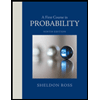
A First Course in Probability (10th Edition)
10th Edition
ISBN: 9780134753119
Author: Sheldon Ross
Publisher: PEARSON
expand_more
expand_more
format_list_bulleted
Question
![Problem # 1.
Functions of random variables:
= ae
a) Let random variable X have probability density function fx(x)
u(·) is the unit step function, and a > 0. Define derived random variable
u(x), where
Y = g(X) = loge [1 − e¯ªX]
–
Find the PDF ƒy(y).
b) Next, consider any continuous random variable W with known PDF, fw(w). Define
derived random variable
Z=h(W) = log. [Fw(W)]
where Fw() is the CDF of W. Find the PDF ƒz(z).](https://content.bartleby.com/qna-images/question/ad306ca9-2ffb-49a4-9b86-39f2ab9633a1/1e195dc9-6a80-4dc1-bdeb-fae2b1913a19/4y6mlma_thumbnail.jpeg)
Transcribed Image Text:Problem # 1.
Functions of random variables:
= ae
a) Let random variable X have probability density function fx(x)
u(·) is the unit step function, and a > 0. Define derived random variable
u(x), where
Y = g(X) = loge [1 − e¯ªX]
–
Find the PDF ƒy(y).
b) Next, consider any continuous random variable W with known PDF, fw(w). Define
derived random variable
Z=h(W) = log. [Fw(W)]
where Fw() is the CDF of W. Find the PDF ƒz(z).
Expert Solution
This question has been solved!
Explore an expertly crafted, step-by-step solution for a thorough understanding of key concepts.
This is a popular solution
Trending nowThis is a popular solution!
Step by stepSolved in 2 steps

Knowledge Booster
Similar questions
- Exercise 6. Using the MGF given by Equation (24), deduce the expressions for the mean and variance we found earlier. Exercise 7. Prove the algebraic identity: 2g2 + xt = + ut 25 2g2arrow_forward6. Roughly, speaking, we can use probability density functions to model the likelihood of an event occurring. Formally, a probability density function on (-x, o0) is a function f such that f(r) 20 and (2) = = 1. (a) Determine which of the following functions are probability density functions on the (-x0, 00). fr-1 00 (b) We can also use probability density functions to find the erpected value of the outcomes of the event - if we repeated a probability experiment many times, the expected value will equal the average of the outcomes of the experiment. (e.g. rf(x) dr yields the expected value for a density f(r) with domain on the real numbers.) Find the expected value for one of the valid probability densities above.arrow_forwardProbability and Statsarrow_forward
- The probability density function of a distribution is given by x f(x) = exp(-7). Use differentiation to show that the probability density function has a maximum at x = 0. The moment generating function of a distribution is M(t) = (q + pet)", where p € [0, 1], q = 1 - p and n is a positive integer. Use the moment generating function to find the mean and variance of the distribution in terms of p, q and n.arrow_forwardSuppose the random variable T is the length of life of an object (possibly the lifetime of an electrical component or of a subject given a particular treatment). The hazard function hr(t) associated with the random variable T is defined by hr(t) = lims-o- P(t ≤ Tarrow_forward
arrow_back_ios
arrow_forward_ios
Recommended textbooks for you
 A First Course in Probability (10th Edition)ProbabilityISBN:9780134753119Author:Sheldon RossPublisher:PEARSON
A First Course in Probability (10th Edition)ProbabilityISBN:9780134753119Author:Sheldon RossPublisher:PEARSON

A First Course in Probability (10th Edition)
Probability
ISBN:9780134753119
Author:Sheldon Ross
Publisher:PEARSON
